The uncertain road to (a) home for City College student
The plan was to stay in a motel for a month, four years later Lola Cheatham’s search is now over.
City College student Lola Cheatham had to live with her daughters out of their vehicle for several years. By Jonny Rico/City Times
April 22, 2019
Story update: A new law prohibiting vehicle habitation in San Diego was sent to a full city council vote by a committee of council members on April 17.
The city council had unanimously voted to repeal an older version of the law on Feb. 5 after a federal judge imposed an injunction, preventing city officials from enforcing the law.
“The Ordinance is both vague on its face and is being arbitrarily and discriminatorily applied, resulting in its unlawfulness,” wrote federal judge Anthony J. Battaglia in his Aug. 21, 2018 ruling on a lawsuit that a handful of disabled San Diego citizens brought against the city.
San Diego City College student Lola Cheatham was someone who was affected by the vehicle habitation prohibition.
Cheatham, who suffered from homelessness for several years, had to live out of her minivan with her three daughters for four years. The city ordinance required her to find a designated safe lot where she could park her minivan overnight.
Since speaking with Cheatham for a Legend magazine story published last fall, she has found an apartment and is taking a semester off from school to adjust her family to their new surroundings. She plans to return to classes in August.
Click here for entire 2018 edition of Legend magazine.
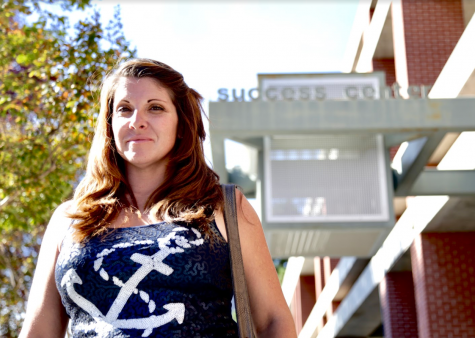
Lola Cheatham is a film major at City College who wants to write and produce movies. By Tiffany Rhiana/City Times
Christmas in a home with her three daughters. That is what Lola Cheatham is wishing for most lately.
Cheatham, a San Diego City College film student and single mother of three, is close to securing that wish. She has been homeless for over four years, living out of her car with her three daughters, ages 13, 6 and 4.
Despite the difficulties of living in a vehicle, Cheatham prefers it over staying at shelters. “We are our own unit,” she said. “We are in a controlled environment.”
In San Diego County, there are 880 homeless people like Cheatham living out of their vehicles, according to a report by the Regional Task Force on the Homeless.
Cheatham, 36, and her daughters have a place where they can park their minivan through the night thanks to the Safe Parking Program operated by the nonprofit Dreams for Change.
The Safe Parking Program offers a place where families and individuals who meet specific requirements can park their vehicles from 6 p.m. to 6 a.m.
Cheatham’s struggle with homelessness began when she separated from the father of her daughters. A realty company pushed out the residents from the apartment complex where she lived, forcing her to move into a motel with her daughters while she searched for a new place.
“I’ve done this before, where our family just cooled our heels in a motel for a month at the longest,” Cheatham said. “Then we’d be able to find a new place to live.”
Her timeline changed, though, when nearly $8,000 of savings were quickly spent living day-to-day in a motel. She had no luck finding a place that would rent to her based on her low income and credit score.
“I don’t know why anyone would rent if they had that type of money,” she said. “It seems like they’d just get a mortgage.”
Cheatham was no stranger to moving into a motel. When she was in high school, her family relocated from Wyoming to Texas. She and her sister lived in a Motel 6 while her brother-in-law attended the University of North Texas.
She later moved out of a Los Angeles apartment to stay at a motel about 15 years ago before getting a place of her own.
Cheatham’s past experience living out of motels made her think her situation would only be temporary while she found a new place for her and her daughters.
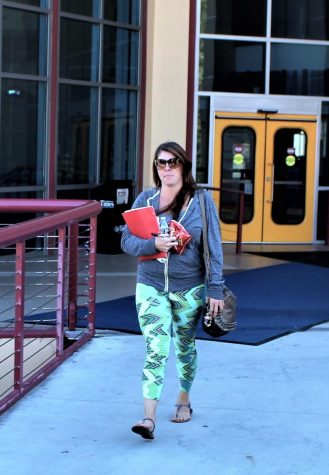
Lola Cheatham want to put what she has learned at City College’s film classes into good use by producing videos on homeless issues. By Jonny Rico/City Times
Four years later, she falls under the definition of suffering from “chronic homelessness.” The U.S. Department of Housing and Urban Development defines a chronically homeless individual as someone who has experienced homelessness for a year or longer, or who has experienced at least four episodes of homelessness in the last three years.
Twenty-five percent of San Diego County’s homeless population falls under HUD’s definition of “chronic homeless.”
One of the struggles Cheatham has found in getting her family back on its feet is the family unit itself.
“Most of the programs are geared for a single person,” Cheatham said. “(The programs are) for someone with mental health illness or drug and alcohol problems or both, someone that just needs a bed for the night or a shower.”
The few times she and her daughters have stayed at a shelter have not been good experiences. One time in particular someone was detoxing in the bed next to Cheatham’s family.
“Not that, that is bad, I don’t judge people,” she said. “But my three children (were) there and asking ‘what’s happening?’ ‘are they ok?’”
The Regional Task Force on the Homeless reports 14 percent of the approximately 4,990 unsheltered homeless suffer from substance abuse.
Drug abuse among the homeless population is a problem that has spilled onto the San Diego City College campus and surrounding areas.
There were 41 drug-related arrest made at City College in 2017, nearly double the 21 drug arrest made in 2016, according to the annual safety report by the San Diego Community College District Police Department.
By comparison, San Diego Mesa College had five drug-related arrests in 2017 and nine arrests in 2016. San Diego Miramar College had one drug-related arrest per year in the same time frame.
“We are having more contact with the homeless and transient population,” said SDCCD police lieutenant Lou Zizzo.
SDCCD police made 42 drug-related arrests as of Oct. 30 of this year, surpassing last year’s 41 and doubling 2016’s 21 drug arrests. According to Zizzo, 41 of those 42 arrests this year were non-students and had claimed to be either homeless or transient.
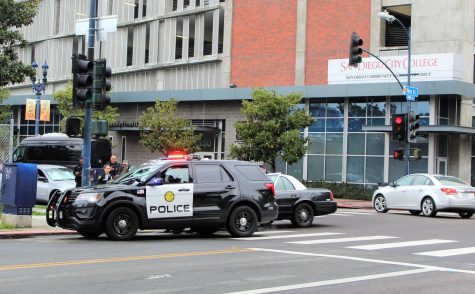
The one student who was arrested for drugs was referred to the Dean of Student Affairs and faced expulsion, according to Zizzo.
In 2017 and 2016, there were zero drug violations referred for disciplinary action.
Zizzo clarified that the stats regarding drug arrests were only those involving “hard drugs.” The lieutenant explained that, since the passing of recreational marijuana laws in California, marijuana incidents were not included in the drug arrests statistics.
Homeless people can seek help and treatment for drug addiction, among many other services, at Father Joe’s Village, also known as St. Vincent de Paul Village, in the East Village section of downtown San Diego.
Cheatham said that throughout her four years living as a homeless person, she has been directed to Father Joe’s, but high demand made it difficult to access the services that the charitable organization offers.
“(Father Joe’s Village) is kind of the mecca of where you go,” Cheatham said. “They provide a meal and a shower if you need it. But it’s an open-air shower.
“My girls won’t eat (the food) because it’s no salt. They try to accommodate everyone’s health concerns, and you know, they’re kids and they don’t eat what they don’t eat.”
While Cheatham did not have the best of luck with Father Joe’s Villages, there is a large portion of the homeless population who benefit through the charity’s housing programs, according to CEO Deacon Jim Vargas.
Of the estimated 8,576 homeless people in San Diego County, 3,586 are in some form of shelter.
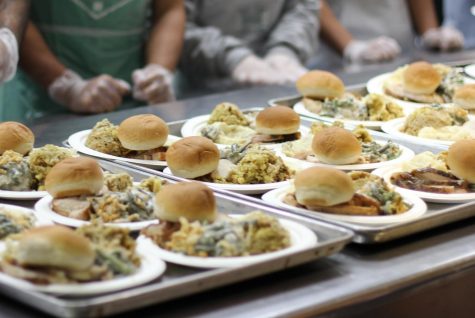
Father Joe’s Village homeless shelter serves three meals a day 365 days a year including the special Thanksgiving dinner. By Jonny Rico/City Times
“We on a nightly basis provide some type of housing, whether it’s emergency shelter all the way up to affordable housing, for about 2,100 individuals,” Vargas said as Father Joe’s Village served its annual Thanksgiving dinner.
“We provide housing and we provide meals, and today is a perfect example of meals. We provide meals 365 days a year — breakfast, lunch and dinner in two dining rooms. Last year we provided over 1 million meals.”
The chefs at Father Joe’s Village prepared over 700 pounds of turkey, 300 pounds of potatoes, 150 pounds of stuffing plus the rest of the Thanksgiving dinner fixings.
The success of the Thanksgiving dinner this year at Father Joe’s Villages was in large part due to Danny Martinez, a retired UFC fighter and community leader.
Martinez organized and provided the workforce of volunteers that showed up to serve the food to the homeless.
“One bad situation can make you homeless, that’s how my dad grew up,” said Martinez, who had a long line of people waiting to say thank you and give him a handshake or a hug.
“When I moved to San Diego, I didn’t have a home. I lived in the gym for three years. These kids (volunteering at Father Joe’s Village from his gym) invited me to their birthday parties and we’re still all together. It’s a community thing.”
Vargas said his organization does more than just offer shelter and food. Father Joe’s Village has a health clinic, which provides mental health services, a substance abuse center and general medical attention.
Father Joe’s Village provides help with child development through teachers, tutors and counselors. They also hold employment training like the 12-week culinary arts program.
According to Vargas, 92 percent of the people who go through the program are able to land jobs as cooks in San Diego restaurants.
But while the services of Father Joe’s Villages help those suffering from homelessness, the only permanent solution according to Vargas is more homes.
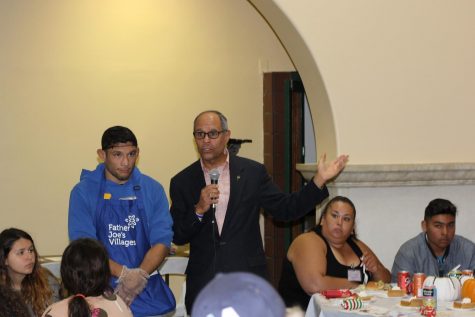
Deccan Jim Vargas and community leader Danny Martinez said grace at Father Joe’s Villages’ Thanksgiving dinner. By Jonny Rico/City Times
“We, Father Joe’s Villages, are building (affordable) housing,” Vargas said. “On 14th and Commercial (there’s) going to be a 14-story building, 407 units (of) studios, one bedrooms, and two bedrooms.
“It’s going to take off the streets approximately 550 people.”
Besides the housing in Barrio Logan, which is set to break ground in 2019, Father Joe’s Village is also preparing a building on 13th Street and Broadway Avenue. Construction on it begins in 2020.
Cheatham is hopeful that she and her family will soon be able to move into a place.
“Someone staying at the safe lot handed me an affordable housing application,” said Cheatham, as she recounted how the road to a possible apartment started.
“At that time I met with the Jewish Family Services, who run one of the other safe lots. I met a housing navigator and worked with her in conjunction with rapid rehousing program, which I got approved for.
“So hopefully we will be moving in soon. Things are looking up, which is really good.”
Although Cheatham and her family have benefitted from services around the San Diego area, chasing down those services can be difficult and at times overwhelming.
This is something San Diego Mayor Kevin Faulconer believes he can fix.
Faulconer convinced the San Diego City Council to unanimously vote to purchase a former indoor skydiving building on 14th Street and Imperial Avenue to turn it into the Homeless Navigation Center.
While the council was united on its decision to buy the building, it was divided on moving forward and funding the Mayor’s navigation center proposal.
“We are doing nothing less than building out a new infrastructure for homeless services,” said Faulconer at the Nov. 13 city council meeting. “Inaction helps no one. I am urging you today to approve the operator contract for the Housing Navigation Center.
“Let’s not regress to the old way of thinking, letting perfect be the enemy of good.”
One criticism of Faulconer’s Housing Navigation Center plan is that it does not include actual housing units.
Cheatham thinks that in order of the Housing Navigation Center to work, the city will have to prepare a large enough workforce.
“Your paperwork passes through 12 desks just to get one service,” Cheatham said. “They better triple their staff.
“If it is going to be any type of improvement, it has to be for everyone involved. Otherwise, the people working for the homeless people are going to be resentful.”
She recalled how she had to see three different people during the rapid rehousing application process. She gave the same information at three different checkpoints, told the same story, all before waiting to see if she was approved.
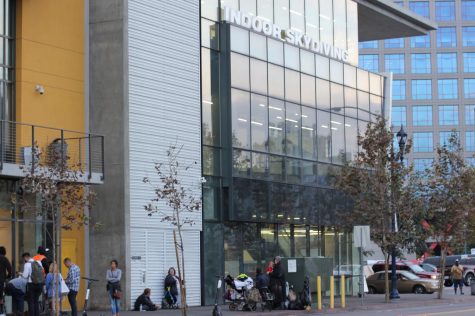
The City of San Diego will turn the old indoor skydiving building into a homeless navigation center. By Jonny Rico/City Times
“Everything could be streamlined,” Cheatham said. “That could be one area where they could bulk up. It doesn’t matter where in the city it is, we’ll find it. But having the manpower to get people in and get them housed (is what matters).”
The inefficiencies in the rehousing process is something that Faulconer will need to address with the Housing Navigation Center, and is a priority for other government leaders like county supervisors or state and federal officials.
In the meantime, Cheatham and her family seem to be on the path to a new three-bedroom apartment.
“We are qualified for the (rapid rehousing) program, which means they help with first month’s and last month’s rent plus all of the deposits and application fees,” Cheatham said. “They then slowly let you take over the lease.”
Despite all of the struggles, Cheatham has kept a positive outlook and said she is thankful she is still able to be around her kids and raise them herself.
She also wants to share her personal experience with homelessness to help others.
“I feel very fortunate for the knowledge that I have learned so far,” she said. “I’ve learned a ton of awesome techniques and history and stuff that has fueled my creative fire for film. So I am really looking forward to taking that and running with it.
“Maybe producing my own videos, maybe get a YouTube channel or something like that. Put my knowledge to good use.”
Correction: Cheatham’s last name was misspelled in the original print edition of the Legend. It is correct in this updated version of the story.


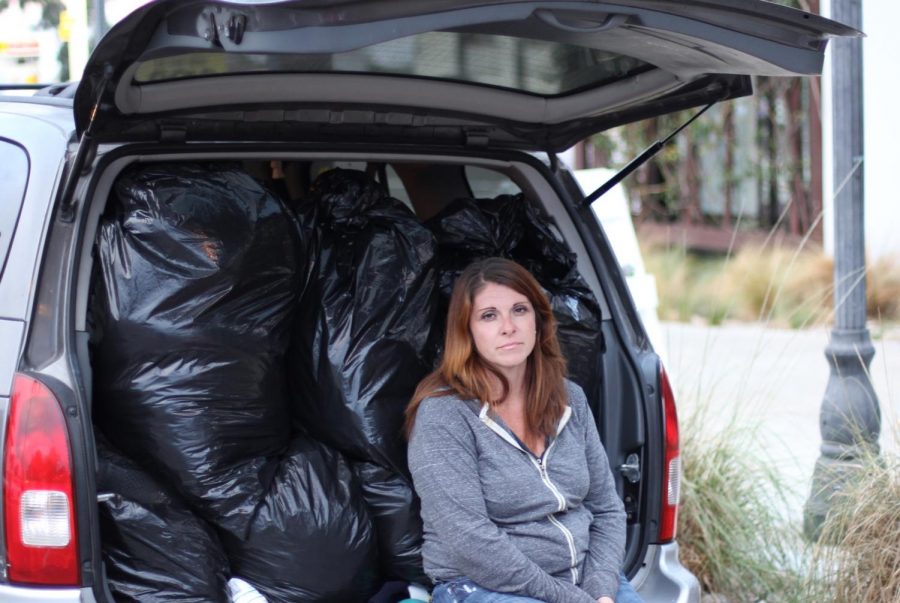
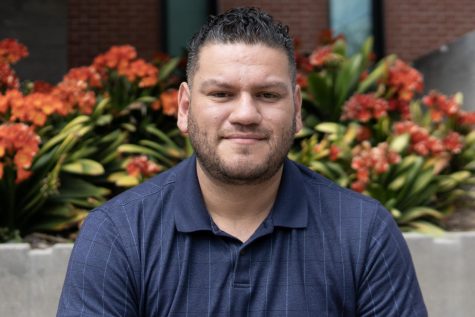








Brian Levene • Apr 24, 2019 at 10:45 am
When I read these profiles of homeless people, it does strike me that there are a lot of choices involved. They are choices that people make that have consequences and they are choices that members of my immediate and extended family made.
1. You plan to have kids. That’s why they call it “Planned Parenthood”. If you have sex with a man and you don’t have a reliable method of birth control, you are planning to have children.
2. National Geographic had an article on people living in their cars, similar to this one. One guy lives with his pit bull. If you have a pit bull, and you can only marginally pay the rent, you have to get rid of the pit bull. No landlord is going to rent to you.
3. Credit problems? You don’t get to live in your own apartment. Live with roommates or in your car until you repair your credit.
Journalists and social workers treat these issues like they treat hurricanes and floods. They are not things that just happen to people. They are the result of decisions people make. There are hundreds of articles written by journalists which start out with “Single mom Karen Smith . . .” where Karen Smith is never asked where the father of the kids is. Is he paying child support? Why did you decide to have children?
We seem to have gotten to a point where even asking these questions makes one seem cold or mean. I am neither. I have family members who I support emotionally and financially who have made decisions similar to these in the past. I do, however, ask them these sort of questions.
This is not the same as asking open ended questions. When you ask people why they became homeless, you get some self-serving answer like, “bad luck” or “ill health”. Ask more pointed questions, like “if your health is bad, why are you smoking?”, and you get a different, often hostile, answer.
Robert Marrow • Apr 23, 2019 at 7:20 am
I would like to point out some misconceptions here.
1: There are approximately 3500 people if not more living in their vehicles at this time. Drive by Mission Bay at night and you will see more than 800 cars along the parking lots.
2. Father Joe’s is NOT a good place to stay unless you like getting your stuff stolen or getting stabbed. There are many incidents that happen there that are never recorded or allowed to be reported.
3: 95% of the people living out of their cars have at least 1 job if not 2. How could we pay for our gas otherwise.
4: Nomads (people living in their vehicles) are being FORCED to living/parking in residential neighborhoods. With limited resources to bathrooms and showers parking in a park that has those resources is necessary for us to work/live. But the police, urged by the City Council tickets everyone at every place after 10pm which makes all the Nomads move into neighborhoods to avoid getting tickets. This is being done Deliberately by the City Council to anger the residents of the city. The Nomads DONT want to live in front of people’s homes! We too are trying to get ahead so that we also can buy homes one day.
5: Nomads ARE NOT the people making huge messes or thefts or other incidents that we are always being accused of. Sure there are some bad apples, but there are bad apples in every group of people wether they are rich or poor. Ask most of the park and rec people Nomads keep their areas clean and don’t try to cause problems. WE do have the right to SLEEP and EAT and go to use bathrooms. People these are natural function, they cannot be turned off at will!
6: STOP judging us by the crazies u see on the street corners screaming at nothing! We are your co-workers and friends and you wouldn’t even know we were homeless if we weren’t being forced into neighborhoods at night, or falsly harrased and arrested by the police on City Councils order.
7: Don’t believe what much of the media says. Reporters that interview homeless people find the very WORST people to talk to.
There is much more that could be said and I tell you the City Council is Lying to ALL of San Diego about what is really going on, like taking away bathrooms and police harrasment and using the homeless as scapegoates making them Hated by communites so you are misdirected at what the City is really got going on. It’s amazing how humans have to always have someone to hate. There is much more that could be said but if at least 1 or 2 people read this and think on it I will be happy! Robert Marrow